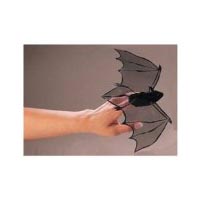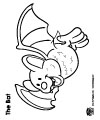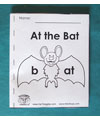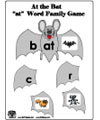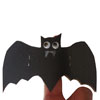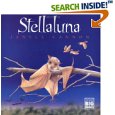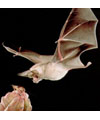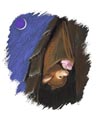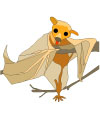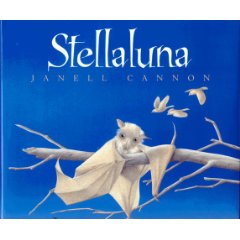Halloween Kids Activities
Bats
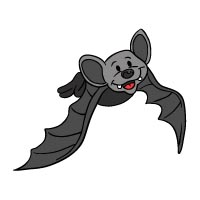
Objectives
Children will use their sense of smell to identify objects.
Children will learn and recite a rhyme.
Children will be able to differentiate between the words "night" and "day."
Materials
- Stellaluna by Jamell Cannon
- Film canisters
- Cotton balls
- Scents: vanilla extract, cinnamon, oil of cloves, etc.
- Egg carton
Directions
To introduce children to bats, read the book Stellaluna by Janell Cannon. The inside book flap summarizes the story this way: "Separated from her mother before she is old enough to fly, Stellaluna finds out that all winged creatures eat fruit. But swallowing food that crawls is just one of the many amazing things this little fruit bat must learn to do. Not all are lessons in survival. For as Stellaluna adapts to the habits of her new family, she learns the essence of friendship in humorous and touching ways."
Bat Sense of Smell Experiment
Stellaluna’s mother uses her sense of smell to identify Stellaluna when they reunited. Many bats leave their babies (pups) in a nursery when they go out hunting for food. Because so many bats live together, a mother bat often has to use her keen sense of smell to find her pup amongst hundreds or thousands of other pups.
Place a cotton ball in six different film canisters, each cotton ball scented with a different scent such as oil of cinnamon, vanilla extract, lemon extract, mint extract, oil of cloves, and witch hazel. Remove the top off an egg carton and place the carton on a table. Have six children sit around the egg carton. Write on masking tape children’s names and tape them to the bottom of canisters. Tell children that they will be pretending to be mother bats and that the canisters are their babies. The egg carton represents the bat nursery. Blindfold children to represent the dark cave. Have children remove the lid from their canister. Give children a few moments to become familiar with their “pup’s” scent. Then, leaving lids off, have children put their canisters in the egg carton nursery. Have children imagine that they are going out to hunt for food.
One at a time, ask children to return to the nursery to find their pup. Once they have found their pup, they should remove it from the nursery. If a child cannot find his/her pup, ask him/her to wait until the other children have found their pups and then try again. It is possible that another child may have chosen their pup. If so, encourage him/her to choose a remaining pup and be ready to describe how its scent differs from his/her pup’s scent.
Have children remove their blindfolds and look at their pups. Have them discuss how they found their pup (sense of smell and position in nursery) and why they might have the wrong pup. Ask how real bats find their pups (sense of smell, position, and hearing).
Movement
Recite the following rhyme together with children and make movements together.
Flap, flap, flap little bats,
Flap, flap, flap little bats,
Flap, flap, flap little bats,
Early in the evening.
Additional Verses:
Clap, clap, clap little bats,
Dance, dance, dance little bats,
Wiggle, wiggle, wiggle little bats,
Soar, soar, soar little bats,
Sleep, sleep, sleep little bats,
Early in the morning.
(Have children pretend to sleep)
Night and Day
Make a sign for night and day. When you hold up the night sign, have children pretend to be bats and fly around. When you hold up the day sign, have children find a place where they can lie down and place place their legs up on a wall or other surface to pretend to be sleeping bats.
Echolocation Game
Before playing the game, explain to children that the ability of animals to locate objects through the use of echolocation. Bats send out sound waves using their mouth or nose. When the sound hits an object an echo comes back. The bat can identify an object and can even tell the size, shape, and texture. Most bats use echolocation to navigate in the dark and to find food.
Choose a child to be the “bat.” Blindfold the child. The rest of the children will play the role of “insects” (bat food). They should spread out randomly around the bat within the designated boundaries. Bat calls out “beep, beep.” The insects respond with “buzz, buzz” as they walk around the area. The bat continues to call out and the insects continue to respond while changing positions. The bat tries to tag an “insect” by listening for the sounds they make and moving in the direction of those sounds. A tagged “insect” must go sit in the “bat cave” (designated area) until the next round. The last person tagged becomes the new “bat.”
Movement Activities

Bats Are Sleeping
Have children pretend to be bats sleeping while singing the song. At the end of the song the "bats" wake up and fly around until you start the song again.
Five Little Bats Hanging Upside Down
Five little bats hanging upside down.
The first little one didn’t make a sound.
The second one said, “I’ll fly far tonight.”
The third one said, “I don’t like sunlight.”
The fourth one said, “I want to eat some bugs.”
The fifth one said, “Let me give you a hug.”
Five little bats hanging upside down.
Shhh! It’s daytime—don’t make a sound!
